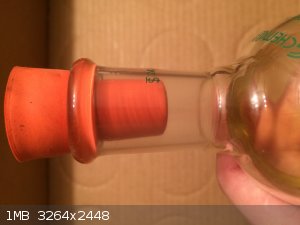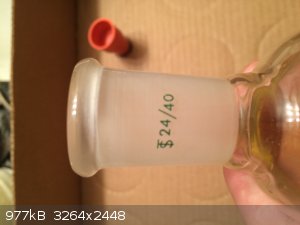FireLion3
Hazard to Others
  
Posts: 218
Registered: 11-1-2014
Member Is Offline
Mood: No Mood
|
|
Does DMSO dissolve..... glass, to any extent?
I feel like this is a dumb question but I have to ask.
For the first time ever I was using DMSO as a solvent in a reaction. The reaction temperature didn't go over 70c. Yet, over the course of the night, I
noticed that the sanded/opaque glass coating on the outside of my 24/40 stoppers was becoming totally clear! I've used these many times before in all
kinds of solvent systems but never has this happened. The DMSO isn't even refluxing or stirring too violently, but it's clear that some of it has made
it's way between the stoppers and the flask-necks.
It would almost seem as if I can push one of the stoppers further into the flask neck than it is supposed to go... as if the outside of the stopper
has been corroded (and yes they are definitely glass not plastic)
I did find a post on researchgate of someone saying that microporous silica is slightly soluble in DMSO, but I know nothing of this.
Is there any reason for me to be concerned here. What is going on?
[Edited on 5-2-2016 by FireLion3]
|
|
|
Detonationology
Hazard to Others
  
Posts: 362
Registered: 5-5-2015
Location: Deep South
Member Is Offline
Mood: Electrophillic
|
|
Have you actually inspected the glass joints separately? It sounds like you have only observed the joint while inside another, correct? I have
noticed that during a reflux or distillation, if I neglect to use joint grease, distillate will become between the joint giving the appearance of
unfrosted glass. I've gotten pretty scared, but it was only an optical illusion. After washing the glass, no damage was observed.
“There are no differences but differences of degree between different degrees of difference and no difference.” ― William James
|
|
|
FireLion3
Hazard to Others
  
Posts: 218
Registered: 11-1-2014
Member Is Offline
Mood: No Mood
|
|
Hm. I did remove one of the stoppers briefly and it still appears to be unfrosted, but then again I didn't wipe it off. Perhaps the liquid layer is
effecting the light that hits it? I just know this is the first time I've ever seen something like this happen. Then again DMSO is a pretty unique
liquid.
|
|
|
Detonationology
Hazard to Others
  
Posts: 362
Registered: 5-5-2015
Location: Deep South
Member Is Offline
Mood: Electrophillic
|
|
Here is a flask of isopropyl formate. The contents are irrelevant.
The joint is wet when the septum is on, and appears to not be a frosted joint. Then after removing and allowing the liquid on the joint to evaporate,
it can be seen the joint is indeed frosted.
 
[Edited on 2-5-2016 by Detonationology]
“There are no differences but differences of degree between different degrees of difference and no difference.” ― William James
|
|
|
Texium
Administrator
       
Posts: 4586
Registered: 11-1-2014
Location: Salt Lake City
Member Is Offline
Mood: PhD candidate!
|
|
Quote: Originally posted by FireLion3  | | Hm. I did remove one of the stoppers briefly and it still appears to be unfrosted, but then again I didn't wipe it off. Perhaps the liquid layer is
effecting the light that hits it? I just know this is the first time I've ever seen something like this happen. Then again DMSO is a pretty unique
liquid. |
Yep, as Detanationology shows with the pictures, that is just a commonly oberved phenomenon that you
can see with any wetted glass joint. It seems to me that the effect is particularly intense when the liquid has a similar index of refraction to the
glass.
|
|
|
Texium
|
Thread Moved
4-2-2016 at 21:59 |